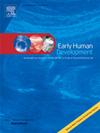Comprehensive assessment of placental inflammation: Novel approach in predicting retinopathy of prematurity
IF 2
3区 医学
Q2 OBSTETRICS & GYNECOLOGY
引用次数: 0
Abstract
The purpose of this study was to determine the independent association between placental inflammation and the development of retinopathy of prematurity (ROP). This retrospective cohort study included 591 neonates born with a gestational age (GA) ≤32 weeks and/or a birthweight (BW) ≤1500 g. Clinical data were retrospectively collected, and placentas were reexamined for acute (e.g. chorioamnionitis and funisitis) and chronic placental inflammation (e.g. chorioamnionitis, villitis of unknown etiology and chronic deciduitis). Severe acute chorioamnionitis was defined as the presence of confluent polymorphonuclear leukocytes or subchorionic microabscesses. Outcomes explored were GA, BW, small for gestational age (SGA), mechanical ventilation duration, postnatal corticosteroids, sepsis, necrotizing enterocolitis, and ROP. Acute histological chorioamnionitis and funisitis were associated with lower GA, lower SGA rates, increased duration of mechanical ventilation and increased ROP rates, while chronic chorioamnionitis and villitis were associated with higher GA and increased SGA rates. BW was significantly lower in neonates with chronic deciduitis. Subanalysis of placentas without maternal and fetal vascular malperfusion also showed increased rates of severe acute chorioamnionitis (42 % vs. 21 %), funisitis (61 % vs. 35 %) in neonates with ROP. Multivariable regression analysis revealed two placental inflammatory factors to be independently associated with ROP: severe acute chorioamnionitis (OR 2.1; 95 % CI 1.1–3.8) and funisitis (OR 1.7; 95 % CI 1.0–2.9). Structured placental evaluation of the presence of severe acute chorioamnionitis and funisitis is valuable in predicting the development of ROP. This increased risk of ROP development could be integrated into the neonatal treatment approach of high-risk neonates in a very early stage in order to reduce ROP.
胎盘炎症的综合评估:预测早产儿视网膜病变的新方法
本研究的目的是确定胎盘炎症与早产儿视网膜病变(ROP)发展之间的独立关联。本回顾性队列研究纳入591例胎龄≤32周和/或出生体重(BW)≤1500 g的新生儿。回顾性收集临床资料,并重新检查胎盘的急性(如绒毛膜羊膜炎和绒毛膜炎)和慢性胎盘炎症(如绒毛膜羊膜炎、病因不明的绒毛炎和慢性蜕膜炎)。严重急性绒毛膜羊膜炎定义为存在融合的多形核白细胞或绒毛膜下微脓肿。研究结果包括GA、体重、胎龄小(SGA)、机械通气时间、产后皮质激素、脓毒症、坏死性小肠结肠炎和ROP。急性组织学绒毛膜羊膜炎和绒毛膜炎与较低的GA、较低的SGA率、机械通气时间增加和ROP率增加相关,而慢性绒毛膜羊膜炎和绒毛炎与较高的GA和较高的SGA率相关。新生儿慢性蜕膜炎的BW明显降低。对没有母体和胎儿血管灌注不良的胎盘的亚分析也显示,ROP新生儿的严重急性绒毛膜羊膜炎(42%对21%)和尿道炎(61%对35%)的发生率增加。多变量回归分析显示,两个胎盘炎症因子与ROP独立相关:严重急性绒毛膜羊膜炎(OR 2.1;95% CI 1.1-3.8)和真菌炎(OR 1.7;95% ci 1.0-2.9)。重度急性绒毛膜羊膜炎和绒毛膜炎的结构化胎盘评估对预测ROP的发展是有价值的。这种增加的ROP发展风险可以在非常早期阶段纳入高危新生儿的新生儿治疗方法,以减少ROP。
本文章由计算机程序翻译,如有差异,请以英文原文为准。
求助全文
约1分钟内获得全文
求助全文
来源期刊

Early human development
医学-妇产科学
CiteScore
4.40
自引率
4.00%
发文量
100
审稿时长
46 days
期刊介绍:
Established as an authoritative, highly cited voice on early human development, Early Human Development provides a unique opportunity for researchers and clinicians to bridge the communication gap between disciplines. Creating a forum for the productive exchange of ideas concerning early human growth and development, the journal publishes original research and clinical papers with particular emphasis on the continuum between fetal life and the perinatal period; aspects of postnatal growth influenced by early events; and the safeguarding of the quality of human survival.
The first comprehensive and interdisciplinary journal in this area of growing importance, Early Human Development offers pertinent contributions to the following subject areas:
Fetology; perinatology; pediatrics; growth and development; obstetrics; reproduction and fertility; epidemiology; behavioural sciences; nutrition and metabolism; teratology; neurology; brain biology; developmental psychology and screening.
 求助内容:
求助内容: 应助结果提醒方式:
应助结果提醒方式:


